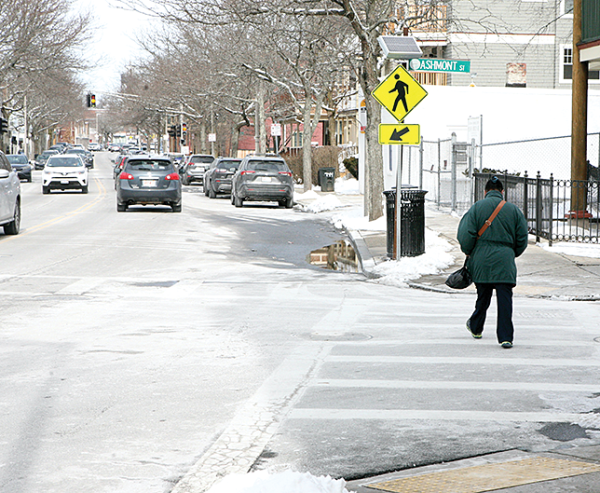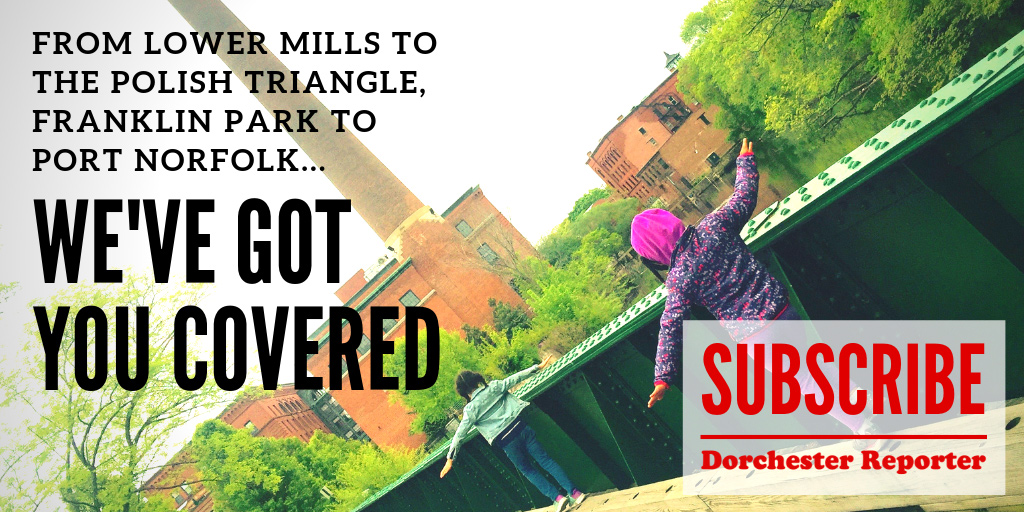February 12, 2025

A pedestrian crosses Ashmont Street on the Washington Street corridor. Despite efforts to make streets safer over the last 10 years, many say they still don’t feel safe when walking. A woman was killed at this location late last year when a turning vehicle hit her in the crosswalk. Seth Daniel photo
Dorchester resident Dean Toulan says that in the seven years he has lived in and walked around his Armandine Street neighborhood, close to Tech Boston High School (formerly Dorchester High School) and the Dorchester YMCA, he has had around 20 near-misses with vehicles on the move.
In November, he was in the middle of a crosswalk on Washington Street when two cars raced down the road right at him.
He was too far across to turn back, and in that moment, Toulan thought: “I’m going to die.”
But both cars slowed down, but they also blew past a red light. The second car narrowly missed him as a scream rang out from another pedestrian. The driver who nearly struck Toulan rolled down his window and yelled at him.
“I don’t want to see a kid get hurt, I don’t want to get hurt, and I almost have been,” Toulan said. “I figured maybe as the neighborhood got better, which it has, there’d be some changes. And it’s worse. It’s just worse.”
Pedestrian safety is an ongoing issue for residents in Dorchester and Mattapan and other city neighborhoods.
A driver struck and killed a pedestrian Jan. 12 in South Boston’s Andrew Square.
Eleven days later, a car crashed into the Ashmont Nursery School in Dorchester, a block from Toulan’s home. Back in December, a woman living nearby was killed by a car while traversing the crosswalk in front of the nursery school. The list goes on.
In 2015, Boston adopted Vision Zero, a national initiative that aims to eliminate fatal and serious traffic accidents by 2030. Since then, the city has increased pedestrian signage, redesigned intersections and lowered speed limits, among other measures. In 2023, it began implementing speed humps throughout city streets.
Vision Zero data show that crashes involving pedestrians have dropped since the initiative began, down to 588 in 2023 from 783 in 2015. But in some high-trafficked areas, residents still don’t think the city has done enough, particularly when it comes to protecting children and older adults.
Vehicles have crashed into Ihorma Breneus’s Mattapan home on busy Cummins Highway three times since 2005. In 2017, she witnessed a car crashing into her porch. The impact shook her home and cracked the foundation.
“When these car crashes happen, they end up on the sidewalk,” Breneus said. “I have kids going to school, people walking to go to work. I mean, for goodness’ sake, I walk every morning, right in front of my house.”
At times, Breneus said, she felt like she was seeing accidents “every day” in front of her home at Cummins and Rugby Road – an area that is in the midst of a major, multi-million dollar roadway reconstruction project aimed at making the corridor safer.
Breneus said she and her mother wrote to the city advocating for better lighting on their streets and guardrails to protect their home, but she felt that nobody was listening, even when they heard of concerns during the re-design process prior to construction.
Above, a view of the Ashmont Street and Washington Street intersection shows the boarded-up section of the Ashmont Nursery School where a car slammed into the building and forced the school to re-locate. Seth Daniel photo
Toulan also wrote to multiple people in city government about what he said was a lack of proper infrastructure at the intersection of Washington and Armandine where he was almost hit. That corridor has several intersections and crosswalks without signals, including at three schools (Henderson Upper School, Codman Academy, and Tech Boston) and the Codman Square library.
“This has been an issue since I moved in, but has gotten progressively worse,” Toulan wrote in December to his city councillor, Brian Worrell. “It is a real danger with the amount of residents and kids moving back and forth between the school and the YMCA on a daily basis without proper infrastructure.”
In an interview with The Dorchester Reporter, Worrell acknowledged Toulan’s concerns, saying that construction crews were not active year-round, and that the city needed to be more transparent about communicating timelines to residents.
“I do hear people calling for more to be done, but there is a process,” Worrell said. “So, I hear the concern, and yes, we should be able to move faster when it comes to pedestrian safety. However, there is a process.”
While walking along Blue Hill Avenue every Sunday, Mattapan resident Fatima Ali-Salaam says she has seen problems that worry her.
“You’ll have some crosswalks that are painted and then some that are almost nonexistent because they haven’t been updated in 80 years,” she said. “Sometimes signals don’t get timed right. In fact, we had one where one side of the street, the button for the traffic signal worked, and then directly across the other side, it didn’t work at all.”
Cummins Highway, Washington Street, and Blue Hill Avenue were all included in Vision Zero Boston’s High Crash Network between 2015 and 2017, on a map that displays the city-owned streets with the “highest density of injury crashes” within the given time period.
City government has begun to act on some of these roads, particularly Cummins Highway where street work is ongoing.
On its website, the city acknowledges the lack of improvements there since 1955, and promises better street lighting, repaved roads and wider sidewalks, green infrastructure, safer crosswalks and designated bike lanes when construction is completed next year.
Cummins Highway “is the biggest transportation project at the moment in the entire system, worth up to $33 million,” said City Councillor Enrique Pepén. “So, there is a lot of attention to that area.”
Along with speed humps and other ongoing projects, Councillors Ed Flynn of South Boston, Pepén, and Worrell each cited multiple measures that they felt would improve safety, including raised crosswalks, traffic bump-outs, and speed cameras that are included in Gov. Healey’s fiscal 2026 budget proposal.
Flynn has specifically pushed to end concurrent pedestrian phasing traffic signals, where cars are allowed to turn while pedestrians are also crossing. The council approved his resolution on the issue unanimously Jan. 15, the same day that Flynn filed a hearing order on the matter of pedestrian safety. If implemented, pedestrians will receive an exclusive block of walking time in crosswalk cycles.
“Right now, the signal allows the pedestrian to walk across the street, and at the same time it allows the vehicle to drive,” Flynn said.
Brendan Kearney, executive director of the pedestrian safety organization WalkMassachusetts, said he disagrees with Flynn’s resolution, saying it will disrupt the flow of traffic and cost too much. He said he does support Flynn’s intention for crosswalks to have appropriate signaling.
“There are 850 signalized intersections in the city of Boston,” Kearney said. “There is some old computer equipment out there that runs some of these intersections, and some of those old signal computers can’t do everything that we want it to do.”
Kearney instead mentioned green infrastructure, which was included in the Cummins redesign. Adding landscape features to the edges of sidewalks would absorb rainwater and reduce “massive amounts of pavement” on the roads, making it safer for pedestrians to cross by shortening crosswalks, he said.
“[The government is] trying more deliberately to think about how we make it safe for all sorts of people to get around, and sometimes that means slowing everyone down,” Kearney said. “That can be a good thing, if we’re doing it thoughtfully.”
For now, most of the suggested plans remain ideas without timelines.
“The neighbors had asked about these speed bumps, specifically on Itasca Street. And I haven’t seen them over there yet, and you still have cars speeding down that small street,” Breneus said. “I haven’t seen them everywhere yet, especially where they were being asked for.”
Toulan does not have children, but he keeps a “Slow Down for Dorchester” sign in his yard for drivers – an idea that communities like Savin Hill pioneered in 2023.
“At some point it needs to be escalated to real action here, because it’s just gone on too long,” Toulan said. “Kids are getting out of school. It’s almost dark. They go to the Y; the parents are double parking. They’re running across the street. It is an absolute nightmare waiting to happen.”
This story is the product of a partnership between The Dorchester Reporter and the Boston University Department of Journalism.
Topics:



